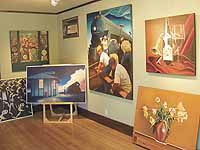| The Boxcar Gallery displays works by local artists Thomas Elmo Williams, David Richie Johnsen, Debbie Johnson, Ervin Johnson and others. Some of the work reflects society as a whole and others spell out the blue collar background of the Carbon County area. |
For the traveller buzzing from Denver to northern California, the vacationer going from Albuquerque to Portland, or anyone driving through Carbon County on Highway 6 not in the know, Helper is just a town built up against the bookcliffs that either greets one as they drive out of the canyon or says goodbye to the Colorado Plateau as a motorist heads up the canyon toward the Wasatch Plateau.
But, as with all cities and towns, there is more there than the naked eye can see. It is a town full of interesting history, from the early settlers who came for the railroad, to the coal miners who frequented the bars and the brothels, to the store owners that hailed from many foreign countries. All these groups are featured in one form or another in the Helper Mining and Railroad Museum.
But there is a new group of settlers to the area, not brand new certainly, but reasonably new. They are the artists of Helper.
Main Street once bustled with traffic headed for the bars and the stores. Today it is quieter, but the storefronts are being resurrected by various businesses and shops, many of them affiliated with the arts.
It is not unusual for small towns, particular mining towns in the west to become something very different from what they were. The very nature of the mining industry has a boom and bust component to it. Park City is known not only as a world class ski resort, but an artists community as well. Jerome, Ariz. has become a tourist mecca, with people drawn by it’s side of the mountain street charm and it’s galleries of fine art. Helper is headed in much that same direction, yet it’s background and it’s position geographically could be it’s best asset.
The galleries, art schools and studios keep popping up. Some have been opened up by local artists who decided to start their own enterprise. Others have been started by people from somewhere else who came to Helper specifically to open a gallery or studio.
| The wood works produced by Char Kelly at Plum Country are wonderful and unique works of art. |
Helper’s Main Street is a perfect venue for art, with its historic buildings and wonderful views. All mediums are practiced, from traditional sculpture to painting, from ceramics to glass, from metal sculpture to wood.
Each Saturday night during the summer Helper holds it Streetfest from four to 10 p.m., where artists and musicians get the chance to show their stuff.
Then in August the town holds it’s annual Helper Art Festival with art displays, crafts, live music and artistic competitions. This year the festival will be held from August 15-17.
Helper’s Main Street is truly a travelers “must do” stop, especially for those that enjoy art blended with history.
It is difficult for almost anyone to evaluate art. Without a background in art and particularly in a certain medium, it is often hard to determine if something is really good. This is particularly true of contemporary art, because many artists in that field have abandoned traditional alliances of inspiration, patronage and form. In their place, the artists have adopted texts, themes and materials that are subject to scrutiny and question.
The historic definition of “art” has been replaced by a cornucopia of possibility because of the favoring of process and concept over final product, the introduction of local and global multiculturalism, continuing expansion of acceptable mediums, rejection of market control and challenges to institutional presentations and traditions. All of this makes for a dynamic that is as exciting and as rapidly changing as the society is. It also can make things confusing.
| One of the best things about visiting Helper is being able to see art creations in the works. This piece by Lisa Palmer, being done in the Karen Jobe Templeton Studio is a frog like figure in a dress called “Cold Feet.” |
Since newly created art has not been subject to the investigations and winnowing of time, a critic’s review is near the beginning of a trail of evaluations that will determine whether a work is a momentary product of trend or an important addition to the arts category. Often this is not easy to predict, as with the famous example of Vincent van Gogh, whose greatness was not recognized while he was alive.
Critics, who have wide ranges of personal taste and professional experience, may arrive at completely varied conclusions.
The expansiveness within the current art world does not suggest the end of the need for evaluative criteria nor should it. Besides, critics, curators, jurors, funding agencies and patrons all ultimately have some set of standards by which they make selection. Continually evolving formal and intrinsic languages call for critical readings appropriate to the new expression.
Factors besides the actual art, such as how it is presented, contribute to a persons opinion. Large exhibitions seem to be a problem for some people but a more significant concern sullying the large exhibitions is that the quality of the work created by artists trying to exhibit at too many venues is becoming compromised.
Evaluating art is a personal thing. The main question anyone has to ask themselves is this.
Was it worth seeing?

